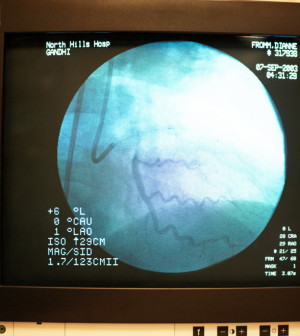- Navigating Your Midlife Crisis: Embracing New Possibilities
- City Raccoons Showing Signs of Domestication
- Mapping the Exposome: Science Broadens Focus to Environmental Disease Triggers
- One Week Less on Social Media Linked to Better Mental Health
- Your Brain Changes in Stages as You Age, Study Finds
- Some Suicide Victims Show No Typical Warning Signs, Study Finds
- ByHeart Formula Faces Lawsuits After Babies Sickened With Botulism
- Switch to Vegan Diet Could Cut Your Greenhouse Gas Emissions in Half
- Regular Bedtime Does Wonders for Blood Pressure
- Dining Alone Could Mean Worse Nutrition for Seniors
Too Much TV Time Tied to Higher Odds for Blood Clot in Lung: Study


People who sit around watching TV for hours on end may raise their risk for a sudden and deadly blockage of a lung artery, new research reveals.
Called a pulmonary embolism, the condition is described by study author Toru Shirakawa as “a serious, sometimes fatal, lung-related vascular disease characterized by sudden onset of symptoms such as chest pain or difficulty breathing.
“[And] the disease is caused by obstruction of the pulmonary arteries by blood clots, generally formed in the leg vessels,” he explained in a news release by the European Society of Cardiology. Shirakawa is a public health research fellow in the department of social medicine at Osaka University in Japan.
Researchers have long noticed that a clot risk appears to be higher among cancer patients and among those taking oral contraceptives. But increased risk has perhaps most often been associated with those who have to lie down or sit for long periods, such as those on cramped, long-haul flights. This particular risk has given rise to a nickname for the condition: “economy class syndrome.”
But now an 18-year-long study involving more than 86,000 people suggests that folks who watch TV for five hours or more a day may also face a significantly elevated risk.
Investigators saw that habitual and prolonged TV viewing doubles the risk for a fatal pulmonary embolism, compared to someone who watches less than 2.5 hours of TV per day.
Shirakawa was to present the findings Monday in London at the annual meeting of the European Society of Cardiology. Research presented at medical meetings is considered preliminary because it is has not gone through a peer-review process.
Study participants ranged in age from 40 to 79. Between 1988 and 1990, they completed questionnaires regarding their TV-viewing habits, and all fatalities were subsequently tracked until 2009.
After accounting for age, gender, blood pressure, diabetes status, smoking and drinking history, height and weight, and exercise routines, the investigators saw that extended TV viewing was linked to higher embolism risk.
When the study team focused solely on those under age 60, the risk went up exponentially, with five hours of TV a day linked to a six times greater risk, compared with those watching 2.5 hours daily. Those under 60 who watched between 2.5 and five hours daily saw their risk triple.
While the researchers found a link between TV watching and embolism risk, the study didn’t prove a cause-and-effect relationship.
“Leg immobility during television viewing may in part explain the finding,” Shirakawa said. “To prevent the occurrence of pulmonary embolism, we recommend the same preventive behavior used against economy class syndrome. That is, take a break, stand up and walk around during the television viewing. Drinking water for preventing dehydration is also important.”
More information
There’s more on pulmonary embolism at the U.S. National Heart, Lung, and Blood Institute.
Source: HealthDay
Copyright © 2025 HealthDay. All rights reserved.










